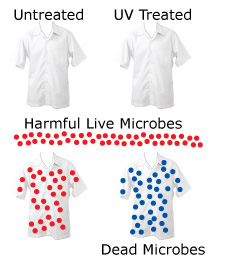Nylon-surfaced fabrics will be treated with deep UV light already shown to impart antimicrobial activity. Treated materials will be exposed to the range of conditions and operations expected for fire and safety personnel garments. Post- testing will verify that microbes are dead.
The Department of Energy's Thomas Jefferson National Accelerator Facility (Jefferson Lab) located in Newport News, Va., has received a $192,000 grant from the Department of Homeland Security to test germ-killing fabrics for police and fire-fighter garments. Jefferson Lab will work with the Newport News Office of Emergency Management to perform the tests.
Will the laser-treated nylon that kills all microbes in the lab perform as well in the real world? Working with the Newport News Office of Emergency Management, Jefferson Lab Scientist Michael J. Kelley will check microbe activity before and after the cloth samples spend months in high-heat environments and police vehicles and stations to get the answer. If "killer nylon" passes the test, the next step will be making garments, air filters and room furnishings. Treated and untreated items will be placed together to show if the treatments keep surfaces free of microbes, such as hospital-specific germs in healthcare settings.
"Durable, affordable antimicrobial fabrics for garments and furnishings will help protect against disease transmission. Antimicrobial packaging films could also help reduce food-borne illness. Possible bioterrorism attacks and deadly new viruses are in the public eye, but antibiotic-resistant germs may be the bigger danger. Making sure those germs die wherever they land will help stop their spread," says Kelley, Jefferson Lab Project Leader and Principal Investigator, who also has a joint appointment with the College of William and Mary as a Professor of Applied Science.
The antimicrobial nylon being used for this real-world study was discovered 15 years ago by a team of DuPont inventors, including Kelley, who was a DuPont scientist at the time. The treatment process involves exposing the nylon to ultraviolet light to change the chemical structure of the nylon at the molecular level. At the time of discovery, the cost of treatment with available ultraviolet lasers was high, and the perceived need for the fabric was low. However, the changing biological threat environment and the expected availability of radically cheaper ultraviolet light from the Jefferson Lab Free-Electron Laser (FEL) has recently renewed interest.
Researchers have sought ways to make surfaces kill germs for more than 50 years. Their chief strategy has been to attach materials known to kill germs to various surfaces. However, high cost, low durability and lack of environmental friendliness blocked the path to broad distribution of these applications. "The strategy for killer nylon is to activate the fabric, not an applied coating, by transforming an exceedingly thin surface of the material. Because this surface is part of the fabric and not an applied coating, it cannot wash off or wear off easily. Because the entire process consists only of shining deep ultraviolet light on the fabric in the absence of oxygen, there are no chemicals used in the process, thus making it environmentally sage. Treated fabric looks, smells and feels just like untreated fabric," Kelley notes.
For more information or to schedule an interview, contact
Debbie Magaldi, magaldi@jlab.org or ph. (757) 269-5102 or
Linda Ware, ware@jlab.org or ph. (757) 269-7689


